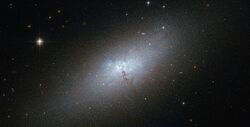Astronomy:NGC 5253
| NGC 5253 | |
|---|---|
 NGC 5253 is one of the nearest of the known Blue Compact Dwarf (BCD) galaxies[1] | |
| Observation data (J2000 epoch) | |
| Constellation | Centaurus |
| Right ascension | 13h 39m 55.9561s[2] |
| Declination | −31° 38′ 24.364″[2] |
| Redshift | 407 ± 3 km/s[2] |
| Distance | 10.9 ± 0.6 Mly (3.33 ± 0.17 Mpc)[3] |
| Apparent magnitude (V) | 10.9[2] |
| Characteristics | |
| Type | Im pec[2] |
| Size | 27,300 ly (8.37 kpc) (estimated)[2] |
| Apparent size (V) | 5.0′ × 1.9′[2] |
| Other designations | |
| Haro 10, ESO 445- G 004, IRAS 13370-3123, MCG-05-32-060, PGC 48334 [2] | |
NGC 5253 is an irregular galaxy in the constellation Centaurus. It was discovered by William Herschel on 15 March 1787.[4][5]
Properties
NGC 5253 is located within the M83 Subgroup of the Centaurus A/M83 Group, a relatively nearby galaxy group that includes the radio galaxy Centaurus A and the spiral galaxy M83 (the Southern Pinwheel Galaxy). NGC 5253 is considered a dwarf starburst galaxy[6] and also a blue compact galaxy.[7]
Supernovae
Two supernovae have been observed in NGC 5253:
- SN 1895B (type unknown, mag. 8) was discovered by Williamina Fleming on 7 July 1895.[8][9][10]
- SN 1972E (Type Ia, mag. 8.5), the second-brightest recent supernova visible from Earth, was discovered by Charles Kowal on 13 May 1972.[11][12] With a peak apparent magnitude of 8.5, the only brighter supernova observed in the 20th century was SN 1987A.[13][14]
Contents
NGC 5253 contains a giant dust cloud hiding a cluster (believed to be a super star cluster) of more than one million stars, among them up to 7,000 O-type stars. The cluster is 3 million years old and has a total luminosity of more than one billion suns. It is the site of efficient star formation, with a rate at least 10 times higher than comparable regions in the Milky Way.[15][16]
Image gallery
-
NGC 5253 imaged by the Hubble Space Telescope
-
The nucleus of NGC 5253 imaged by the Hubble Space Telescope
References
- ↑ "A Peculiar Compact Blue Dwarf Galaxy". ESA/Hubble Picture of the Week. http://www.spacetelescope.org/images/potw1248a/.
- ↑ 2.0 2.1 2.2 2.3 2.4 2.5 2.6 2.7 "NASA/IPAC Extragalactic Database". Results for NGC 5253. http://nedwww.ipac.caltech.edu/.
- ↑ Ferrarese, Laura; Ford, Holland C.; Huchra, John; Kennicutt, Robert C. Jr. et al. (2000). "A Database of Cepheid Distance Moduli and Tip of the Red Giant Branch, Globular Cluster Luminosity Function, Planetary Nebula Luminosity Function, and Surface Brightness Fluctuation Data Useful for Distance Determinations". The Astrophysical Journal Supplement Series 128 (2): 431–459. doi:10.1086/313391. Bibcode: 2000ApJS..128..431F.
- ↑ The scientific papers of Sir William Herschel by J. L. E. Dreyer. Royal Astronomical Society London 1912.
- ↑ Seligman, Courtney. "New General Catalogue Objects: NGC 5253". https://cseligman.com/text/atlas/ngc52a.htm#5253.
- ↑ Jordan Zastrow; M.S. Oey; Sylvain Veilleux; Michael McDonald; Crystal L. Martin (2011). "An Ionization Cone in the Dwarf Starburst Galaxy NGC 5253". The Astrophysical Journal 741 (1): (page needed). doi:10.1088/2041-8205/741/1/L17. Bibcode: 2011ApJ...741L..17Z.
- ↑ "Hubble Spots a Peculiar Compact Blue Dwarf Galaxy". NASA. 30 November 2012. http://www.nasa.gov/mission_pages/hubble/science/ngc5253.html.
- ↑ Pickering, E. C. (1896). "A New Star in Centaurus. The new Algol Variable in Delphinus". Astronomische Nachrichten 139: 249–250. doi:10.1002/asna.18961391604. Bibcode: 1896AN....139..249P.
- ↑ Kowal, C. T.; Sargent, W. L. W. (Nov 1971). "Supernovae discovered since 1885". Astronomical Journal 76: 756–764. doi:10.1086/111193. Bibcode: 1971AJ.....76..756K.
- ↑ "SN 1895B". IAU. https://www.wis-tns.org/object/1895B.
- ↑ Kowal, C. T. (18 May 1972). "Supernova in NGC 5253". Central Bureau for Astronomical Telegrams (Smithsonian Astrophysical Observatory, IAU) 2405: 1. http://www.cbat.eps.harvard.edu/IAUCs/IAUC2405.png. Retrieved 15 August 2025.
- ↑ "SN 1972E". IAU. https://www.wis-tns.org/object/1972E.
- ↑ I. D. Karachentsev; M. E. Sharina; A. E. Dolphin; E. K. Grebel et al. (2002). "New distances to galaxies in the Centaurus A group". Astronomy and Astrophysics 385 (1): 21–31. doi:10.1051/0004-6361:20020042. Bibcode: 2002A&A...385...21K.
- ↑ I. D. Karachentsev (2005). "The Local Group and Other Neighboring Galaxy Groups". Astronomical Journal 129 (1): 178–188. doi:10.1086/426368. Bibcode: 2005AJ....129..178K.
- ↑ Stuart Wolpert (March 18, 2015). "More than a million stars are forming in a mysterious dusty gas cloud in a nearby galaxy" (Press release). UCLA. Archived from the original on March 19, 2015.
- ↑ J. L. Turner; S. C. Beck; D. J. Benford; S. M. Consiglio et al. (2015). "Highly efficient star formation in NGC 5253 possibly from stream-fed accretion.". Nature 519 (7543): 331–333. doi:10.1038/nature14218. PMID 25788096. Bibcode: 2015Natur.519..331T.
External links
Template:NGC objects:5000-5499
 |


